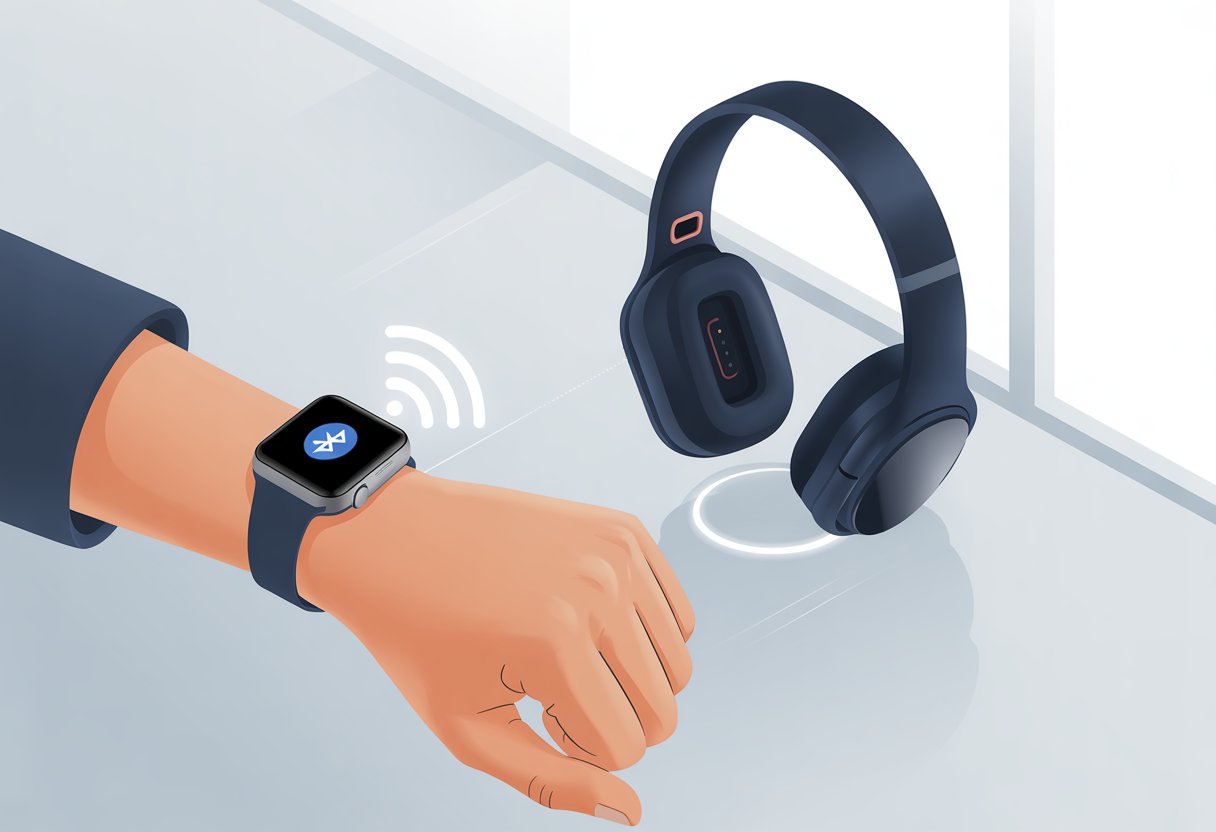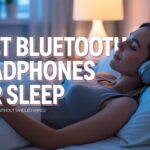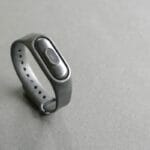Ever notice people at the gym or out for a walk, looking like they’re talking into their wrists? It’s not some secret agent stuff—it’s just Bluetooth doing its thing. We can connect Bluetooth headphones to our smartwatch and listen to music, stream podcasts, or even take calls, all without messing with our phones.

Getting this set up is way easier than matching socks.
Most smartwatches like Apple Watch or Galaxy Watch have Bluetooth settings that let us pair headphones with just a few taps.
If you want a quick how-to, check out these tips for pairing earbuds with a smartwatch.
Honestly, once we go wireless with our smartwatch and headphones, it’s hard to imagine going back to untangling cords.
The freedom to leave our phones behind but still enjoy music or take calls from our wrist is just too good to give up.
Pairing Bluetooth Headphones with Your Smartwatch
Let’s get our Bluetooth headphones connected to our smartwatch so we can listen to music, answer calls, or just look extra cool with zero tangled wires.
With a bit of patience (and maybe some deep breaths), we’ll get this working without too much hassle.
Enabling Bluetooth on Your Smartwatch
First, let’s make sure our smartwatch isn’t just ignoring all the Bluetooth headphones nearby.
We open the Settings app on the smartwatch and look for the Bluetooth menu.
Toggle Bluetooth ON. Some watches show a blue symbol to say, “I’m ready!”
We’ll probably see a list of available devices.
If Bluetooth doesn’t turn on right away, don’t freak out.
Sometimes a smartwatch needs us to swipe, long-press, or even restart before it wakes up and feels social.
Different brands love calling things by different names.
For example, on a Wear OS watch, we go to Settings > Connectivity > Bluetooth.
If you’re lost, there’s more help on Google Wear OS Help.
Activating Pairing Mode on Headphones
Now it’s time to get our headphones waving their hands, yelling “Pick me!”
Most Bluetooth headphones go into pairing mode when we press and hold the power button for a few seconds.
Usually, flashy lights or funky beeps let us know pairing mode is on.
If nothing obvious happens, checking the manual (yeah, we all avoid it) actually helps.
Look for flashing blue or red lights.
Make sure no other devices are stealing our headphones’ attention.
Disconnect from any phones, laptops, or that old tablet gathering dust.
If headphones still don’t show up, turn them off and try again.
Sometimes they just need a quick nap and a fresh start.
Connecting Devices Successfully
With Bluetooth on the smartwatch and headphones in pairing mode, it’s time to bring them together.
On our smartwatch, the headphones should pop up in the list, sometimes with a name like “SuperBass 09” or something a little dramatic.
Tap the name to start connecting.
Some watches ask us to confirm or enter a code (it’s usually 0000 or 1234).
The devices might take a few seconds to get friendly.
Once they’re paired, we’ll probably hear a chime or see a happy message.
Now’s the time to test it out—play music, make a call, or just enjoy the sweet sound of wireless freedom.
If you want more tips, check out connecting headphones to a smartwatch.
Smartwatch Settings for Bluetooth Audio
Before we jump into an audio adventure, it helps to know where our watch keeps all the buttons, switches, and digital trap doors.
Having control over settings makes pairing, switching, or even unpairing headphones way less confusing.
Accessing the Audio Settings
First things first, let’s actually find the audio settings—unless we want to swipe endlessly.
On most smartwatches, we press the power or home button to wake up the screen.
Next, swipe down from the top or up from the bottom (why do they all do it differently?).
Tap the gear icon labeled “Settings.”
Look for “Bluetooth” or “Connections”—manufacturers love to keep us guessing.
Inside the Bluetooth menu, we should see a list of available devices.
If our headphones aren’t there, put them in pairing mode.
Headphones usually flash or beep to get our attention.
Tap the name of our headphones, wait for the handshake, and voilà—paired!
Need more details? Google’s guide on connecting Bluetooth devices to your watch is pretty handy.
Managing Connected Devices
Life gets crowded fast, even on our wrists.
Managing connected Bluetooth devices is a bit like deciding which pet gets the best spot on the couch.
To see all our current connections, head back to the Bluetooth menu.
Here, we’ll see every device our watch remembers—some probably from Bluetooth flings long ago.
Tap a device’s name to connect or disconnect it.
To unpair, find the little “i” or gear next to the device and tap “Unpair.”
If audio keeps switching weirdly, sometimes unpairing everything and starting over helps, as people mention in this music control discussion.
Here’s a quick checklist:
- Connect new headphones by tapping them in the list.
- Unpair old ones when things feel messy.
- Forget devices you don’t use to avoid awkward run-ins.
Playing Music and Multimedia
We all want our smartwatch and Bluetooth headphones to work together like a perfect duet.
Whether we’re dancing on the bus or ignoring chores at home, being able to stream music and control playback from our wrist just makes life better.
Streaming Music via Smartwatch
When we stream music from our smartwatch, we get to leave our phones behind and still jam out.
Lots of smartwatches let us transfer music files directly or use apps like Spotify to play music right from the watch.
Some watches store songs on the device, while others need Wi-Fi or LTE for streaming.
We usually start by putting our Bluetooth headphones in pairing mode and connecting them through the watch’s Bluetooth settings.
After that, we can play music like a tiny DJ strapped to our wrists.
If we’re using a Samsung smartwatch, the built-in music app lets us play and control songs.
We get access to our favorite playlists and can hit play or skip whenever we want.
Most modern smartwatches handle music and call audio at the same time, so we don’t have to pick between tunes and catching Grandma’s call.
Controlling Playback on Your Headphones
Once our Bluetooth headphones are connected, we get to control playback like music bosses.
Some headphones let us pause, skip, or change the volume with buttons or touchpads.
If our watch supports it, playback controls on the screen mean we can change songs without digging for our phone.
Here’s what we can usually do:
- Play/Pause from headphones or the watch
- Skip Tracks using side buttons or swipe gestures
- Change Volume with physical buttons or the watch dial
- Switch audio sources if our devices allow
If both the watch and headphones connect via Bluetooth at the same time, things go pretty smoothly.
Pairing is usually quick, and the watch remembers our headphones for next time.
Still got questions? Check this step-by-step guide on connecting Bluetooth headphones to a smartwatch for more help.
Using Bluetooth Headphones for Calls and Notifications
If we want to keep our hands free and look a bit futuristic, using Bluetooth headphones with a smartwatch is a game-changer.
We get vibrations or sounds in our ears for notifications, and we can even answer calls from our wrist—no phone scramble needed.
Receiving Notifications through Headphones
When we sync our smartwatch and Bluetooth headphones, notifications can land right in our ears.
We might hear a soft chime or a spoken alert for messages, emails, or app notifications—even if our phone is buried somewhere.
Some smartwatches read notifications out loud.
A message pops up, and the watch’s voice assistant gives us a quick summary through our headphones.
It’s like having a tiny personal assistant in our ear (minus the coffee runs).
To set this up, we usually:
- Pair the smartwatch with our phone
- Pair headphones with either the watch or phone (usually the phone)
- Make sure notifications are set to announce via connected audio
If we get a bunch of notifications at once, most systems queue them up.
The real challenge? Not laughing out loud if someone texts us something hilarious during a boring meeting.
Handling Calls Using Smartwatch Audio
Incoming calls get interesting with Bluetooth headphones and a smartwatch.
Instead of digging for our phone, we answer straight from our wrist and talk through our headphones.
How this works depends on our devices.
Many smartwatches let us answer calls, but sometimes the audio comes out of the watch instead of the headphones.
To fix this, we check Bluetooth connection settings and make sure call audio goes to the headphones, not just the watch.
Some users say that on certain phones and watches, answering on the watch makes the audio come out of the watch—not ideal.
If that happens, we can tweak the phone’s Bluetooth menu or change audio output settings.
The best part?
We don’t have to fish our phone out of tight jeans or a bottomless backpack.
Just tap the smartwatch and start talking—hopefully about something more exciting than a car warranty.
Fitness Tracking with Bluetooth Headphones
When we use Bluetooth headphones with our smartwatch, we get the best of both worlds. Cardio turns into a private concert, and we sneak a peek at our heart rate stats without anyone noticing.
Staying healthy can actually be fun—sometimes even a little louder than the neighbors would like.
Listening to Workout Music
Honestly, working out in silence? That’s rough. Syncing Bluetooth headphones to a smartwatch lets us control music from the wrist, so we don’t have to fumble with our phone.
We can build playlists, queue up our favorite tracks, or follow along with audio workouts. Most smartwatches let us download songs and connect to headphones directly. That means we can leave the phone at home and skip the weird pocket bulges.
If our smartwatch supports streaming apps, great! If not, downloaded tracks work just fine. Simplicity has its perks.
Not every headphone works with every smartwatch, so we should check compatibility before buying. Once we hit play, the headphones connect wirelessly and the music just starts.
If our workout playlist is “Eye of the Tiger” on repeat, hey, no judgment here.
Sometimes pairing can be a headache. Some devices offer a special Bluetooth audio mode for easier setup, and you can see this with certain Samsung smart watches.
Monitoring Heart Rate During Exercise
We don’t have to guess if our pulse is racing from the workout or that new song. Most smartwatches use built-in sensors to check heart rate, so we get instant feedback.
Live updates show up right on the watch, even if we’re singing at full volume. Many fitness apps chart our heart rate zones, letting us know if we’re slacking or going full beast mode.
Some smartwatches buzz our wrist if our heart rate gets too high (or when we think we’re sprinting but we’re actually just chasing the ice cream truck).
If we love data, we can check our history, compare stats, and see if that playlist really helps us perform. Heart rate readings stay steady while we jam out, thanks to better sensors and band designs.
If our heart rate spikes during a slow song, it’s probably just excitement. Still, we’ll keep an eye on it.
Battery Life Considerations
Connecting Bluetooth headphones to a smartwatch asks a lot from two tiny batteries that probably wish they had a break. We can keep the music going and our steps counted by using a few smart tricks.
Optimizing Power Use During Pairing
Pairing is where it all starts. When we connect Bluetooth headphones to a smartwatch, both devices use extra battery.
It’s kind of like opening the fridge at midnight—quicker is better.
- Turn off Wi-Fi on the smartwatch while pairing to save energy.
- Keep both devices close together. If we wander off, the gadgets have to work harder, draining more power.
- Don’t pair a bunch of devices at once. The smartwatch can get overwhelmed and lose battery even faster.
After pairing, disconnect Bluetooth if we’re not using the headphones for a while. Smartwatch users say their battery lasts much longer after disabling Bluetooth.
Maximizing Headphone and Smartwatch Longevity
If we want our batteries to last, let’s treat them gently. Turning on power-saving mode on the smartwatch is like tucking it in—it limits background tasks and stretches battery life.
Most smartwatches have special settings for this. Lowering the volume on the headphones helps too. High volume drains battery faster, and our ears (and neighbors) will thank us.
Charging both devices regularly—before they get too low—keeps them healthy. Avoid letting batteries drain completely, and update software when possible.
Small changes like these can make a big difference, as users who enable power-saving modes often discover.
Troubleshooting Common Connection Issues
Bluetooth can be as stubborn as a cat when pairing headphones with a smartwatch. But we can avoid frustration with a few handy steps.
Knowing how to handle pairing problems and reconnect after a dropout—Bluetooth, not romance—saves time and sanity.
Fixing Bluetooth Pairing Problems
First up, check if Bluetooth is actually on for both the smartwatch and headphones. It sounds silly, but even tech nerds forget.
If Bluetooth is off, nothing connects, and we end up talking to ourselves.
Before pairing, put the headphones in pairing mode. Usually, that means holding down a button until a blinking light shows up. The flashing is normal, even if it feels aggressive.
Head into the watch’s settings and pick Bluetooth. When the headphones pop up, tap them with pride.
If nothing shows, maybe we’re accidentally trying to pair with a neighbor’s toaster.
A classic fix: turn off Bluetooth, count to five (sheep optional), and turn it back on. This move solves more tech issues than we’d like to admit.
Samsung watches even have a step-by-step guide for this.
If it’s still not working, check for software updates. Outdated firmware silently ruins Bluetooth connections.
Reconnecting After Disconnection
If the connection drops, blame Bluetooth first—not yourself. Sometimes we just need to bring the devices closer together. Walls, pockets, or even our own bodies can block the signal.
Try forgetting the headphones on the smartwatch and “re-pairing.” In settings, find the headphones, hit “Forget,” and go through the pairing process again. It’s Bluetooth amnesia, but it works.
If the watch refuses to connect, make sure the headphones aren’t busy with another device like a phone or laptop. Devices get jealous.
Disconnect the headphones from everything else, then try again.
Restarting both gadgets helps too. The classic “turn it off and on again” really does fix more than it breaks, and we get a moment to breathe.
If problems stick around, check for updates or known Bluetooth issues with our specific watch or headphones. Even Reddit has threads about weird Bluetooth quirks that remind us we’re not alone.
Compatibility with Smartphones and App Store Integration
Let’s be real, technology gets picky. Not every smartwatch wants to hang out with every smartphone, and app stores sometimes act like exclusive clubs.
Getting devices to play nice together usually takes some research and a few downloads.
Checking Smartphone and Smartwatch Compatibility
Before we get too excited about streaming music from our wrist, we should make sure our smartphone and smartwatch actually want to work together.
Grab the smartphone (iPhone or Android) and check the smartwatch’s compatibility list.
Most smartwatches say, “I work with iOS and Android!” but some only work with one or limit features.
Apple Watches only team up with iPhones. Samsung and other smartwatches often work with both Android and iPhones, but crossing the streams can mean missing features.
It’s smart to visit official support pages or check the box for “compatible with iOS” or “supports Android,” so we don’t end up with an expensive wrist ornament.
Lists and charts compare which models work best, and a quick online search usually reveals the truth faster than texting a techy friend.
Downloading Companion Apps from the App Store
After making sure our devices actually get along, let’s pop over to the app store. Every smartwatch seems to insist on its own companion app, and honestly, these apps make it a lot easier to connect to Bluetooth headphones, track your fitness, and who knows what else.
If you use an iPhone, you’ll want to check the App Store. Android users? Head for Google Play instead.
Type in the official app by the brand’s name. For instance, if you’ve got an Apple Watch, you’ll need the Apple Watch app. Samsung fans usually go for Galaxy Wearable.
Make sure you grab the right app—downloading random stuff from unknown developers isn’t just risky, it’s honestly not worth the headache. The correct app unlocks features and keeps updates rolling in without you having to think about it.
The store usually points out compatible apps, and user reviews can give you a sense of whether an app’s actually easy to use or just loves to crash.
- How to use Bluetooth headphones with a smartwatch: Because Wires Are So Last Century - October 30, 2025
- Why do my Bluetooth headphones not cancel noise? Common Culprits Behind Your Noisy Headphones - October 29, 2025
- How to use a smartwatch for contactless payments and leave your wallet in the Stone Age - October 29, 2025






